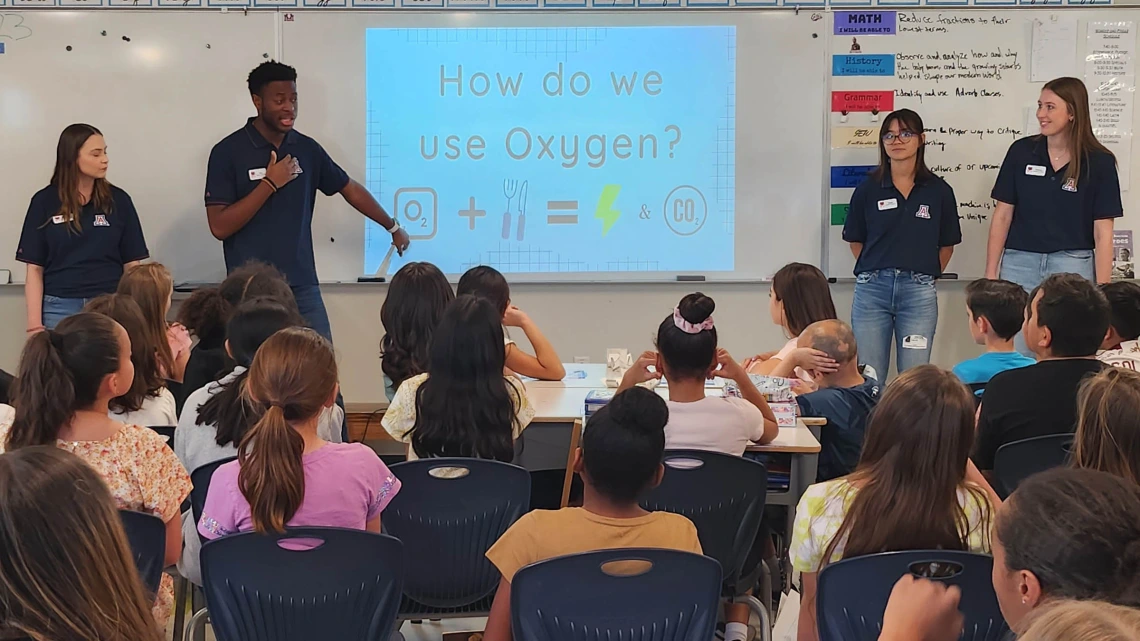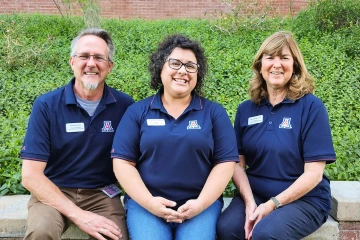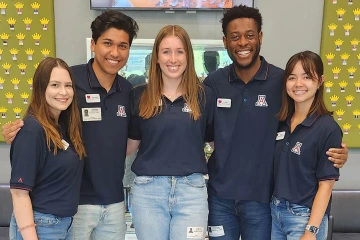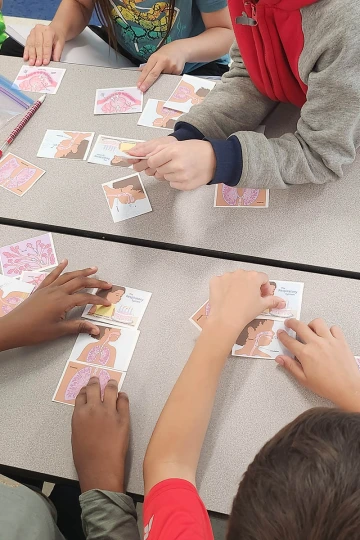An innovative approach to increase health literacy
The K-12 Health Literacy Project is introducing the importance of science and health to local students while training future providers to communicate effectively.

University of Arizona student interns in the Health Connectors program presented science and health information to elementary school children as part of a UArizona Health Sciences initiative to increase health literacy.
It was an unusually cloudy day when Asher, who had just obtained his driver’s license, was driving his friend Remy home from school. The two high school students were listening to music in the car and talking about their class project when it started to rain. As the roads became slick, Asher lost control of the vehicle. They rolled over and crashed into a concrete barrier, becoming two of more than 227,000 teenagers injured in car crashes each year in the United States.

Kevin Kehl, MS, Amber Price, MSN-Ed, RN, and Cindy Rankin, PhD, oversee the K-12 Health Literacy Program at the University of Arizona Health Sciences.
It is a very real situation for far too many high schoolers, but fortunately in this case, Asher and Remy were characters in a simulation. The broken bones, concussion and burns they suffered are not real, but Asher and Remy’s road to recovery will introduce a class of high school students to the human body’s muscular, skeletal and nervous systems.
The scenario is one of several used in the K-12 Health Literacy Project, a University of Arizona Health Sciences effort to enhance science and health literacy in K-12 educational venues.
The K-12 Health Literacy Project has two components:
- “Life of a Disease,” was offered as a pilot to more than 200 Tucson-area high school students who worked through scenarios such as the one above during the last school year. In the future, students may have the potential to earn dual credit through their school and three credits as a science elective at the University of Arizona.
- A K-8 Health Connectors program is offered as an internship through the UArizona College of Nursing. The program was piloted in third- and fourth-grade classrooms this spring.
“We established the K-12 Health Literacy Project to encourage and inspire kids at an early age to become engaged in science and health,” said Cindy Rankin, PhD, executive director of the K-12 Health Literacy project and associate professor in the Department of Physiology at the UArizona College of Medicine – Tucson. “We want them to have a sense of knowledge and empowerment to ask questions and aspire to be a part of solutions as they grow older that will push the health care system forward.”
The program is designed to address the fact that many people lack a general foundation of health knowledge. According to the National Assessment of Adult Literacy Survey, only 12% of U.S. adults are proficient in health literacy.
“Our goal is for our students to learn to break health literacy down so that others understand how they can make informed decisions for themselves.”Amber Price, MSN-Ed, RN
“In a general sense, health literacy is about understanding your body, how it interacts with the environment and what responsibilities you have as a person to keep your body healthy,” Rankin said. “It's not that everybody should completely understand physiology and medicine, but at least know the kinds of questions you should ask or the type of information you should be asking for.”
Low health literacy has been associated with people who are older, have limited educations, earn lower incomes, have chronic health conditions or are non-native English speakers. Adults with low health literacy are more likely to experience a greater number of hospital visits, longer stays and higher health care costs.
Geography and distance from health care providers can also be a limiting factor, including in Arizona where only 39% of the state’s primary care physician needs are being met. This leaves many residents, especially those in rural areas, without a primary care provider.
“For many people without primary care, the emergency room is their primary care. That’s not a viable lifelong health approach,” Rankin said. “In addition to more physicians, we can do a better job educating people about their own health so they have a better understanding of how to interact with the health care system.”
An opportunity for change
Amber Price, MSN-Ed, RN, lecturer in the UArizona College of Nursing, leads the K-8 Health Connectors program, which is designed to help college students seeking careers in health care become better educators and communicators of health information. The lessons they learn are demonstrated in presentations to local third- and fourth-grade classrooms, where kids are introduced to health and science in a fun and engaging way.

(From left) Olivia Brodersen, Brandon Fuentes, Samantha Kremer, Tobe Emeka and Sage Liu participated in the inaugural Health Connectors course and traveled to local elementary schools to share health care knowledge with third- and fourth-grade students.
“Whether my students are going to become doctors, nutritionists or public health professionals, they are going to talk to patients in some way. It is important for them to understand their audience and communicate on their level, whether they are talking to children or grown-ups,” Price said. “Our goal is for our students to learn to break health literacy down so that others understand how they can make informed decisions for themselves.”
During the spring semester, the interdisciplinary pilot course included students from across the campus, including the UArizona College of Medicine – Tucson and the UArizona Mel and Enid Zuckerman College of Public Health.
Kevin Kehl, MS, senior program manager for the K-12 Health Literacy Project, identifies local schools interested in participating in the program and coordinates with teachers to identify topics that are of interest to their students.
Price first teaches students the basics of childhood growth and development. Then, students learn best practices for teaching the information to a lay audience and develop lessons plans to be presented to the third- and fourth-grade students at the end of the semester.
“These students are all focused on careers in health care, but I think they were all struck by the gap in health education and knowledge people have about health,” Price said. “I think they all realized this gap is a real opportunity, and this class was a first opportunity for them to see how they can help change that.”
This past spring, the Health Connector interns talked to students from two local elementary schools about blood flow, blood typing, respiration and oxygenation.
"The reactions the kids had to our students going to their classrooms was amazing to see,” Price said. “It was a fun way for them to learn and ask questions. For them, it was like, ‘Wow, I want to go to the college and be just like them.’”
A better understanding of health and careers
To launch the dual-credit high school course, Rankin partnered with Beth Francis, MS RN, manager of the Health Care Professions at the Pima County JTED Health Care Program, to develop the “Life of a Disease” course, which was redesigned from an existing JTED course. The scenario-based curriculum covers basic anatomy, physiology, pathology, clinical and professional skills, and career exploration.

Third- and fourth-grade students took part in interactive activities as part of the K-12 Health Literacy Program’s outreach to local schools.
Six JTED instructors enthusiastically participated in the pilot program, as did Kehl, who is a science teacher at a local parochial school. Rankin worked with the teachers on the use of scenarios to help these high school students connect with the course content and brought them to the university for sessions with clinical experts, who addressed the health issues that might arise in each scenario, such as injuries sustained in a car crash. Burn specialists shared information about dermal burns and new techniques for treatments, orthopedists discussed how they determine whether someone needs surgery, and emergency medicine specialists offered insights into how they approach calls and transporting patients from rural areas.
“The instructors got expertise beyond what they will be sharing as part of the course, but it gives them the credibility and the little extra they can share with students if the questions come up,” Rankin said. “It also helps them connect with physicians, researchers, technicians, professors and others at the university so that they know where to find the resources to help their students that might want to pursue one of these careers.”
After the course, the JTED students expressed how much they liked the scenario-based structure of the course, specifically how they could personify the characters with their own unique names and identities to make the situations relevant to their school and fellow classmates. Many times, they expanded on the scripted scenarios as they developed their own questions. For instance, if someone broke a bone in an accident, students wondered how the injury affected the character’s ability to play an instrument, compete in sports or be part of another extracurricular activity.
With a successful pilot semester behind them, Rankin and Kehl are continuing their relationship with JTED and hope to expand the program into more local high schools.
“The students really enjoyed this course because it was different than most any course they have taken before,” Rankin said. “The scenarios felt real, and I think that is what brought these students so close to the material. It truly engaged them in both health sciences and health literacy. Beyond an understanding of what health is, they learned how to find the information they need for their own health and opened their eyes to the wide range of potential careers in the health sciences.”
Our Experts
Cindy Rankin, PhD
Executive Director, K-12 Health Literacy Project
Associate Professor, Department of Physiology
Amber Price, MSN-Ed, RN
Lecturer, College of Nursing
Kevin Kehl, MS
Senior Program Manager, K-12 Health Literacy Project
Contact
Blair Willis
UArizona Health Sciences
520-419-2979
bmw23@arizona.edu

